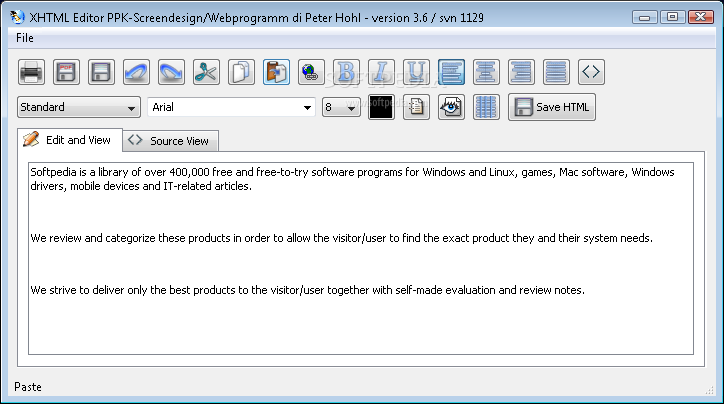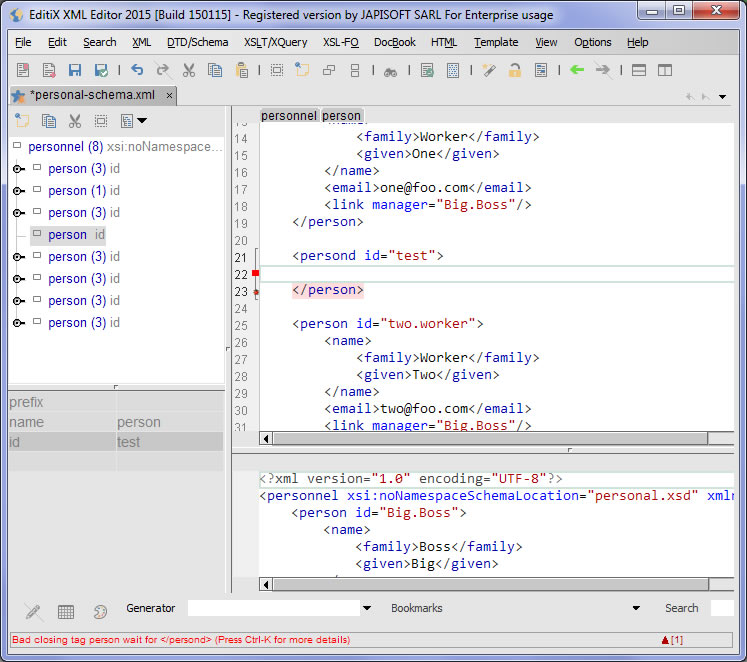
- Xhtml.editor.to.storage.generic.error
- Xhtml Editor Free
- Free Xhtml Editor Downloads
- Xhtml Editor Eclipse Plugin
WYMeditor: web-based XHTML editor
An XHTML editor is an environment designed for authoring XHTML. An XHTML editor is not usually found as a stand-alone product. It is quite common to find an XHTML editor incorporated in a product that provides a more comprehensive package of web development editors. For example, a software package might combine and XHTML editor with an HTML editor. There are three classes of free (X)HTML/CSS editors:. lightweight - loads fast, does syntax highlight and other basic functions, perhaps has remote editing and plugins. The leading, standards-compliant plug-in XHTML WYSIWYG editor for Windows and browser-based (IE / Firefox) content management systems. Multilingual, fully customizable. Generates clean XHTML Strict or 1.1 m.
Overview
WYMeditor is a web-based WYSIWYM (What You See Is What You Mean) XHTML editor (not WYSIWYG).
WYMeditor's main concept is to leave details of the document's visual layout, and to concentrate on its structure and meaning, while trying to give the user as much comfort as possible (at least as WYSIWYG editors).
WYMeditor has been created to generate perfectly structured XHTML strict code, to conform to the W3C XHTML specifications and to facilitate further processing by modern applications.
With WYMeditor, the code can't be contaminated by visual informations like font styles and weights, borders, colors, ...
The end-user defines content meaning, which will determine its aspect by the use of style sheets. The result is easy and quick maintenance of information.
As the code is compliant to W3C XHTML specifications, you can for example process it using a XSLT (at the client or the server side), giving you a wide range of applications.

Xhtml.editor.to.storage.generic.error
Why WYMeditor ?
Do you modify your website using a content management system (CMS)? Do you allow your clients to modify their website with a CMS?
If yes, you have certainly met de difficult choice of a web-based (X)HTML editor.
- You may have tried a full-featured WYSIWYG editor, but you apprehend that your clients use it inappropriately, with the risk it degenerates visually and on the code quality.
- You may also have tried the BBcode syntax, Markdown or the wiki-style syntax, but you don't want to force your clients to solutions that are too technical/complex for them, even if it tends to generate good quality code.
WYMeditor brings a new approach and a set of simple solutions which allow for a very easy to use editor, while still producing clean XHTML code. Thanks to its original approach it remains clear and easy to learn. A one-hour training and it's the beginning of clean updates made by the end user.
How can I contribute ?
If you like WYMeditor and the freedom it brings to the web developer, don't hesitate to give some help.
WYMeditor is Free/Open Source Software, which means anyone can use it and contribute. It also means community support is important to make it a really solid and long-lasting project.
Any help and feedback is welcome, either on GitHub, or on the forum.
Applications using WYMeditor
WYMeditor has been integrated in many open or proprietary applications, such as:
- MediaWiki PHP wiki engine
- Drupal PHP CMS (using the WYSIWYG API module)
- CMS Made Simple PHP CMS
- Midgard Open Source Content Management Framework
- Symphony PHP XSLT CMS
- Radiant Rails CMS
- Refinery Rails CMS
- TYPO3 PHP CMS
- SPIP PHP CMS
- MODx PHP CMS
- XOOPS CMS
- ExpressionEngine CMS
- CMSity content management system engine
- django-cms (v2) Django CMS
- dango-page-cms Django CMS
- Website Baker CMS
- SkyBlueCanvas PHP CMS
- NanoCMS PHP CMS
- sNews PHP CMS
- Redaxo PHP CMS
- Frog CMS
- Wolf CMS
- Nirepress CMS
- Orbis CMS
- Poko CMS
- EPiServer C#-.NET CMS
- gidooCMS Java CMS framework
- WordPress PHP blog tool
- Dotclear PHP blog tool
- Byteflow Python/Django blog engine
- GroupServer Zope Collaboration Server
- OpenCRX Enterprise Java Open Source CRM
- Rails framework
- Django framework
- Symfony framework
- CakePHP framework
- CodeIgniter framework
- Gyro-PHP application framework with behaviour
- ExtJS JavaScript framework and RIA platform
- Jelix framework
- TypeRoom website editing tool
- Galaxy opensource scalable framework for tool and data integration
- Vocalo.org social media website
- Adminer database management in single PHP file
- PolicyStat policy and procedure management for healthcare
Xhtml Editor Free
License
Free Xhtml Editor Downloads
WYMeditor is dual licensed under the Open Source MIT and GPL licenses.
HTML is HyperText Markup Language, a language derived from SGML (Standard Generalized Markup Language) and used on the World Wide Web to create structure for the presentation of documents and create links between them, using tags and a set of rules. XML is EXtensible Markup Language and simplified SGML. XHTML is EXtensible HTML, a markup language that combines features of HTML and XML, with stricter rules than those applied in HTML coding. An XHTML editor is an environment designed for authoring XHTML.
Xhtml Editor Eclipse Plugin
An XHTML editor is not usually found as a stand-alone product. It is quite common to find an XHTML editor incorporated in a product that provides a more comprehensive package of web development editors. For example, a software package might combine and XHTML editor with an HTML editor. A more complete package could include an HTML editor, XHTML editor, CSS (Cascading Style Sheets) editor, and JavaScript® editor.
XHTML editors often have both a text editor in which to input XHTML and a WYSIWYG (What You See Is What You Get) editor, and sometimes it’s possible to show only the WYSIWYG window. The purpose is to allow a user who hasn’t learned the technical aspects of web design, such as markup languages and CSS, to still be able to generate and edit content. However, one problem with web pages and websites being built with correct XHTML has been WYSIWYG editors that do not generate proper markup. XStandard® points out the problem and makes XHTML WYSIWYG Editor™ to address this, assuring that only markup that meets best practice criteria is used.
One important feature you may find in an XHTML editor is the ability to choose the version of XHTML you are working on. Adobe® Dreamweaver® CS4, for example, offers a choice of XHTML 1.0 Transitional, XHTML 1.0 Strict, XHTML 1.1, or XHTML 1.0 Mobile. HTML 4.01 Transitional and HTML 4.01 Strict are also offered.
In any case, there are some other features that may be present in an XHTML editor. One valuable feature that is not universally offered is XHTML validation. Alternatively, dynamic correction may be offered along with an error log file. An HTML to XHTML conversion feature may also be included. Other desirable features include syntax highlighting, word wrap, and UTF-8 Unicode (8-bit UCS/Unicode Transoformation Format) — UCS stands for Universal Character Set — to enable work on multilingual files.